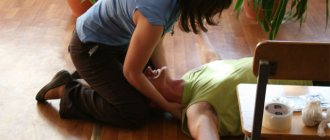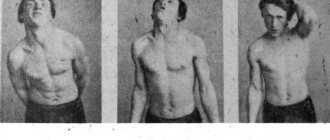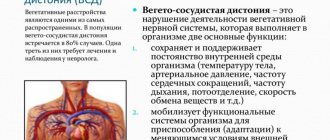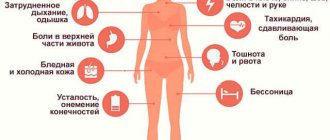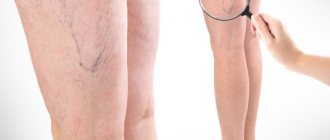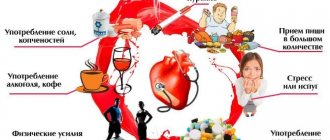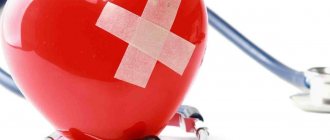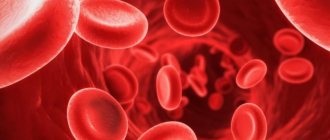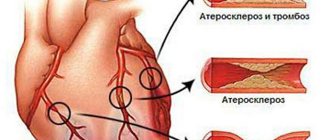Fever with VSD is one of the symptoms that causes a lot of concern for people with this disease. Moreover, for its occurrence it does not require special conditions in the form of extreme heat or a closed room, it is enough to get excited and experience stress. In other cases, this manifestation may occur without reference to any events at all.
Causes of fever during VSD
Normal functioning of the human body is carried out at a temperature of 36.6 degrees. If changes in numbers are observed on the thermometer in the direction of increasing or decreasing, we may be talking about the presence of hidden pathological processes in the body.
Disturbances in the functioning of the autonomic nervous system cause frequent increases in body temperature. Moreover, these changes should not be significant; most often the difference is no more than 1 degree. Body temperature is determined by the work of a special organ - the hypothalamus.
Violations of body thermoregulation can be observed not only in the presence of diseases of internal organs, but also under the influence of the stress hormone - adrenaline, on the hypothalamus. This process actively develops during stress on the body.
Changes in temperature may be accompanied by a headache (other causes of ailments of this kind can also cause its appearance). This condition may appear once or twice a week, or haunt a person throughout the day.
Causes of sudden fever with dystonia:
- the central nervous system, having lost the ability to maintain a balance between the sympathetic and parasympathetic departments, does not allow the brain to function properly. During the functioning of the sympathetic department, vasoconstriction is observed, during which blood flows to the heart, after which the process of warming the body begins. All this time, a person experiences negative manifestations in the form of stomach spasms, changes in blood pressure and sleep disturbances;
- When a person finds himself in a stressful situation or develops associations with some kind of fear, his subconscious mind comes into play, producing an appropriate reaction from the body;
- small changes in the state of one’s own health cause a person to have a panic attack, leading to the fact that the face and body are engulfed in heat and the person experiences increased sweating.
Regular hot flashes can cause serious somatic pathologies, therefore, once you experience them yourself, you should immediately contact a specialist. The doctor will prescribe diagnostic measures, and after them, appropriate therapy.
Drug treatment of vegetative-vascular dystonia
Vegetative-vascular dystonia (symptoms and treatment in women require attention and an integrated approach) is treated with a wide range of drugs with different effects.
These include:
- muscle relaxants – help relax muscles and normalize nervous processes;
- chondroprotectors - prescribed for osteochondrosis and VSD, help maintain the integrity of the vertebrae and reduce pain;
- antidepressants – eliminate signs of fatigue and anxiety, promote rapid sleep;
- beta blockers - normalize heart rate and blood pressure.
Muscle relaxants:
1. Mydocalm:
- a drug that has a local anesthetic effect inhibits the release of neurotransmitters and the flow of calcium ions into the corresponding channels;
- prescribed in white, film-coated tablets;
- You need to take 1 tablet orally 3 times a day before meals;
- the drug is contraindicated during pregnancy and breastfeeding, as well as in case of individual intolerance to this drug.
2. Xeomin:
- a drug that acts on peripheral nerves, inhibiting the release of acetylcholine;
- prescribed as a solution in white bottles;
- should be used parenterally by intramuscular injection with the participation of qualified specialists (the dose is prescribed individually);
- the drug is contraindicated for persons under 18 years of age, as well as for infectious diseases, pregnancy and individual intolerance to substances.
3. Baklosan:
- a muscle relaxant that affects the central nervous system, reduces the risk of pathological muscle contractions;
- prescribed in biconvex white tablets;
- You need to take ½ tablet orally 3 times a day before meals, increasing the dose every three days until the desired result is achieved;
- the drug is contraindicated in case of epilepsy, seizures, psychosis, pregnancy and breastfeeding; if you have a history of diabetes mellitus, you should consult your doctor.
Chondroprotectors:
1. Suplazin:
- a medicine used to normalize joint function and eliminate pain;
- prescribed in solution for injection;
- apply parenterally 2 ml intra-articularly, preheating to 25°C. It is better to use the help of a doctor, because intra-articular injection requires special qualifications;
- the drug is contraindicated in case of individual intolerance to the drug.
2. Ostenil:
- a drug that has an analgesic effect;
- prescribed in solution for injection;
- apply parenterally by intra-articular administration of the required dose of the drug only as directed by a doctor;
- the drug is contraindicated in case of individual intolerance to the drug.
Antidepressants:
1. Amitriptyline:
- a drug that has an analgesic and sedative effect;
- prescribed in tablets and white dragees;
- take 25-50 mg orally before bed after meals, gradually increase the required dose to 200 g over 3 days;
- Contraindicated in case of heart attack, treatment with psychotropic drugs, alcoholism, pregnancy.
2. Moclobemide:
- a drug with antidepressant and immunomodulatory effects;
- prescribed in white tablets;
- You need to take 600 g orally 3 times a day after meals;
- Contraindicated in cases of exacerbation of mental illness, pregnancy and breastfeeding.
3. Fluoxetine:
- a drug that eliminates the feeling of depression, is responsible for the deposition of the hormone of happiness - serotonin;
- prescribed in white tablets;
- take 2 tablets morning and evening;
- Contraindicated for epilepsy, seizures, liver and kidney failure, glaucoma.
Beta blockers:
1. Atenolan:
- a drug that has an antiarrhythmic effect. Used for tachycardia and high blood pressure;
- prescribed in white, film-coated tablets;
- You need to take 50 g orally 1 time per day, increasing the dose to 200 g 2 times;
- Contraindicated for hypotension, heart failure, bronchial asthma, metabolic syndrome.
2. Niperthene:
- a drug with antiarrhythmic and antihypertensive effects;
- prescribed in white tablets, 10 g each;
- take orally 1 time per day;
- Contraindicated for persons under 18 years of age, as well as for hypotension, heart failure, bronchial asthma, and metabolic syndrome.
Each drug listed can only be prescribed by a doctor, since they all have a large number of side effects and features in use.
Hot flashes with VSD
Heat in the head often accompanies an attack of fear, as a typical manifestation of this condition. During such an attack, the blood seems to come close to the skin of the face, like a giant hot wave, gradually covering the entire human body.
Hot flashes, which are not accompanied by an increase in temperature, are symptoms of cervical osteochondrosis that occur when nerve endings are compressed. In addition, this is a typical manifestation of vegetative-vascular dystonia, arising for the following reasons:
- disturbances in the regulatory function performed by blood vessels;
- vasomotor type disorders.
As a rule, hot flashes are a consequence, but the causes of such symptoms can be:
- hereditary predisposition;
- restructuring of the body during changes in hormone levels;
- prolonged exposure to situations of severe stress and constant tension;
- period after heavy physical exertion;
- neurotic disorders;
- presence of bad habits.
Hot flashes can be associated not only with dystonia, but also with other conditions:
- viral diseases;
- menopause;
- diseases of the endocrine system;
- hypertension.
If a person has vegetative-vascular dystonia, a feeling of heat occurs during panic attacks, while external factors do not have any significance on the appearance of this condition.
What to do?
Yoga has a positive effect on the condition of patients.
First of all, those suffering from attacks of VSD need to lead a healthy lifestyle. To do this, you need to follow the basic recommendations:
- Spend more time outdoors. Oxygen is directly involved in saturating brain cells.
- Engage in physical activity. You can sign up for yoga, swimming, dancing.
- Eat right. Food should be fresh and contain vitamins for the proper functioning of the nervous and cardiovascular systems. For example, magnesium, calcium, phosphorus, vitamin A, E, C.
- Get enough sleep. Sleep duration is at least 8 hours; hypotensive patients require 10-12 hours.
- Eliminate nervous stress. You can’t worry and get irritated for no reason, try to control your emotions.
If hot flashes occur suddenly, it is recommended:
- Go to a calm, cool place, in the shade. Take 10 deep breaths and exhalations, try to relax.
- Get rid of negative thoughts and switch your attention to something pleasant.
- Relax. If a wave of sweat pours down due to overexertion and prolonged stress.
- Take sedatives and sedatives. Carry appropriate medications with you to relieve an attack and normalize blood pressure.
If your face is constantly red, your heart is pounding, there is noise in your head, sweat is released, you can use aromatherapy. Oils can soothe and help with excessive sweating.
If other factors influencing the sudden feeling of heat are excluded, and VSD is recognized as the main cause, it is worth following all the doctor’s recommendations, since such surges negatively affect the heart, blood pressure and the functioning of almost all internal organs. An important aspect in the treatment of the disease will be visiting a psychotherapist. The doctor will help you understand the hidden sources of the subconscious, normalize your well-being, and get rid of internal experiences and phobias. Fever may be a sign of tachycardia with VSD.
Hot flashes during the premenstrual period
Situations when a woman has a fever during the period when there are several days left before the onset of menstruation are not uncommon. This phenomenon has not yet been fully studied, although scientists have confirmed the fact of mutual influence of changes in hormonal levels and emotional lability of the fair sex.
When a woman feels sweaty and hot during the premenstrual period, there is an increase in blood pressure, pain in the head and stomach, she needs to see a doctor who will select medications to alleviate this condition.
Prescription of serious medications, as a rule, is not used; most often they are used:
- therapeutic exercises;
- changing the existing rest and work regime to the correct one;
- conversations with a psychotherapist or psychologist.
Among medications, the doctor may prescribe:
- oral contraceptives;
- antiallergic drugs;
- diuretics;
- vitamin complexes;
- anti-inflammatory drugs;
- nootropics;
- antidepressants;
- tranquilizers.
The last three categories are prescribed only in extremely severe cases of manifestations of vegetative-vascular dystonia.
Recommendations
If you are regularly bothered by the symptoms of VSD and the heat outside lasts all day, but you need to find the strength to go to work or leave the house if necessary, then you should follow these recommendations:
- Always wear a hat and cover your head to protect it from direct sunlight.
- Carry a bottle of pre-chilled water with you.
- Keep fast-acting sedatives with you so that if a sudden attack develops, you can immediately provide first aid.
- To protect your heart, you need to take Valocordin or Corvalol, which you should also have in your mobile first aid kit in your purse.
- To normalize blood sugar levels, which go off scale in a stressful situation, you need to eat a bar of chocolate, a cake or something sweet, washed down
- If an attack of vegetative-vascular dystonia develops, provoked by heat, you need to leave crowded places - supermarkets, public transport, etc.
VSD is a pathology with which you can live and feel like a full-fledged person, you just need to follow simple recommendations and avoid provoking factors!
Heat during menopause
Autonomic dysfunction can complicate the period of menopause in women, adding hot flashes to the existing unpleasant symptoms. Their occurrence is due to age-related changes, during which the functioning of the reproductive system undergoes a transformation.
At normal temperatures, heat in the body occurs mainly at night, it quickly spreads throughout the body and is accompanied by a number of additional symptoms:
- increased sweating;
- increased heart rate;
- headache;
- redness of the skin of the face, arms, legs and neck;
- chills.
Low-grade fever during VSD can last for about half an hour in women, gradually disappearing. To normalize a woman’s condition during this difficult period for the body, you should:
- donate blood for hormones;
- change your diet to a balanced one;
- organize regular physical activity;
- take antidepressants (only on the recommendation of a specialist).
Prevention
Many people know that preventing a disease is much easier than getting rid of it later. Therefore, in order not to treat VSD, you should take care of its prevention in advance. Especially if there have already been cases of such a disorder in the family, for example, on the female side of the mother or grandmother.
You can overcome VSD by following simple rules:
- adjust physical/intellectual stress;
- introduce more vegetables and various fruits into the diet;
- observe drinking regime;
- take an annual vacation - go on vacation, travel out of town;
- ensure a good night's rest - in a ventilated, cool room;
- avoid stressful situations.
Of course, autonomic dysfunction, if it has formed, can remain with a person for life. However, it is better to ask your doctor in advance how to get rid of VSD and whether it can be defeated.
Chills and its causes
Disturbances in thermoregulation, leading to the spread of heat throughout the body, can be expressed in chills. This symptom has characteristic features:
- feeling of chilliness;
- coldness enveloping the limbs;
- body tremor;
- inability to stay warm in warm clothes or under a blanket;
- muscle tremors;
- the appearance of goose bumps.
Chills may occur in the presence of infectious inflammatory diseases, such as a cold, influenza virus or bronchitis. This reaction of the body is a completely natural response to changes in the course of ordinary metabolic processes in the body.
To alleviate the condition, the following is indicated:
- drinking hot tea;
- taking a warm shower or bath;
- warming up in bed, under the covers.
If chills occur frequently, you should consult a doctor; this symptom may be a sign of several serious diseases:
- arterial hypertension;
- neurosis;
- hormonal disorders;
- pathologies of the endocrine system.
To make a correct diagnosis, it is important to visit a therapist, endocrinologist, or gynecologist.

